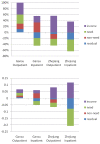Growing old before growing rich: inequality in health service utilization among the mid-aged and elderly in Gansu and Zhejiang Provinces, China
- PMID: 22947369
- PMCID: PMC3447639
- DOI: 10.1186/1472-6963-12-302
Growing old before growing rich: inequality in health service utilization among the mid-aged and elderly in Gansu and Zhejiang Provinces, China
Abstract
Background: China's recent growth in income has been unequally distributed, resulting in an unusually rapid retreat from relative income equality, which has impacted negatively on health services access. There exists a significant gap between health care utilization in rural and urban areas and inequality in health care access due to differences in socioeconomic status is increasing. We investigate inequality in service utilization among the mid-aged and elderly, with a special attention of health insurance.
Methods: This paper measures the income-related inequality and horizontal inequity in inpatient and outpatient health care utilization among the mid-aged and elderly in two provinces of China. The data for this study come from the pilot survey of the China Health and Retirement Longitudinal Study in Gansu and Zhejiang. Concentration Index (CI) and its decomposition approach were deployed to reflect inequality degree and explore the source of these inequalities.
Results: There is a pro-rich inequality in the probability of receiving health service utilization in Gansu (CI outpatient = 0.067; CI inpatient = 0.011) and outpatient for Zhejiang (CI = 0.016), but a pro-poor inequality in inpatient utilization in Zhejiang (CI = -0.090). All the Horizontal Inequity Indices (HI) are positive. Income was the dominant factor in health care utilization for out-patient in Gansu (40.3 percent) and Zhejiang (55.5 percent). The non-need factors' contribution to inequity in Gansu and Zhejiang outpatient care had the same pattern across the two provinces, with the factors evenly split between pro-rich and pro-poor biases. The insurance schemes were strongly pro-rich, except New Cooperative Medical Scheme (NCMS) in Zhejiang.
Conclusions: For the middle-aged and elderly, there is a strong pro-rich inequality of health care utilization in both provinces. Income was the most important factor in outpatient care in both provinces, but access to inpatient care was driven by a mix of income, need and non-need factors that significantly differed across and within the two provinces. These differences were the result of different levels of health care provision, different out-of-pocket expenses for health care and different access to and coverage of health insurance for rural and urban families. To address health care utilization inequality, China will need to reduce the unequal distribution of income and expand the coverage of its health insurance schemes.
Figures
Similar articles
-
Influencing factors of inequity in health services utilization among the elderly in China.Int J Equity Health. 2018 Sep 15;17(1):144. doi: 10.1186/s12939-018-0861-6. Int J Equity Health. 2018. PMID: 30219075 Free PMC article.
-
The comparison of healthcare utilization inequity between URRBMI and NCMS in rural China.Int J Equity Health. 2019 Jun 14;18(1):90. doi: 10.1186/s12939-019-0987-1. Int J Equity Health. 2019. PMID: 31200711 Free PMC article.
-
Identifying determinants of socioeconomic inequality in health service utilization among patients with chronic non-communicable diseases in China.PLoS One. 2014 Jun 24;9(6):e100231. doi: 10.1371/journal.pone.0100231. eCollection 2014. PLoS One. 2014. PMID: 24960168 Free PMC article.
-
Population health in an era of rising income inequality: USA, 1980-2015.Lancet. 2017 Apr 8;389(10077):1475-1490. doi: 10.1016/S0140-6736(17)30571-8. Lancet. 2017. PMID: 28402829 Review.
-
Inequalities in Older age and Primary Health Care Utilization in Low- and Middle-Income Countries: A Systematic Review.Int J Health Serv. 2022 Jan;52(1):99-114. doi: 10.1177/00207314211041234. Epub 2021 Oct 21. Int J Health Serv. 2022. PMID: 34672829 Free PMC article.
Cited by
-
Utilization of elderly health promotion services during COVID 19 in Iran: A cross-sectional study.J Educ Health Promot. 2022 Sep 28;11:297. doi: 10.4103/jehp.jehp_1315_21. eCollection 2022. J Educ Health Promot. 2022. PMID: 36439010 Free PMC article.
-
The Reimbursement Rate of New Rural Cooperative Medical Scheme and Self-Rated Health Among Rural Middle-Aged and Elderly.Front Public Health. 2022 Apr 8;10:627169. doi: 10.3389/fpubh.2022.627169. eCollection 2022. Front Public Health. 2022. PMID: 35462832 Free PMC article.
-
General practice for the poor and specialist services for the rich: inequality evidence from a cross-sectional survey on Hangzhou residents, China.Int J Equity Health. 2019 May 14;18(1):69. doi: 10.1186/s12939-019-0966-6. Int J Equity Health. 2019. PMID: 31088453 Free PMC article.
-
Disparity in reimbursement for tuberculosis care among different health insurance schemes: evidence from three counties in central China.Infect Dis Poverty. 2016 Jan 27;5:7. doi: 10.1186/s40249-016-0102-4. Infect Dis Poverty. 2016. PMID: 26812914 Free PMC article.
-
Unmet needs of activities of daily living among a community-based sample of disabled elderly people in Eastern China: a cross-sectional study.BMC Geriatr. 2018 Jul 11;18(1):160. doi: 10.1186/s12877-018-0856-6. BMC Geriatr. 2018. PMID: 29996778 Free PMC article.
References
-
- Gill I, Kharas H. An East Asian Renaissance: Ideas for Economic Growth. World Bank, Washington DC; 2007.
-
- Eichengreen B, Park D, Shin K. When Fast Growing Economies Slow Down: International Evidence and Implications for China. NBER Working Paper No. 16919, ; 2011.
-
- Chen S, Ravallion M. The Developing World Is Poorer than We Thought, But No Less Successful in the Fight against Poverty. The Quarterly Journal of Economics. 2010;125(4):1577–1625. doi: 10.1162/qjec.2010.125.4.1577. - DOI
-
- China 2030. Building a Modern, Harmonious, and Creative High-Income Society. World Bank and Development research Centre of the State Council, PRC. World Bank, Washington; 2012.
-
- International Database U.S. Census Bureau. , ; . http://www.census.gov/ipc/www/idb/]
Publication types
MeSH terms
Grants and funding
LinkOut - more resources
Full Text Sources
Medical
Miscellaneous


